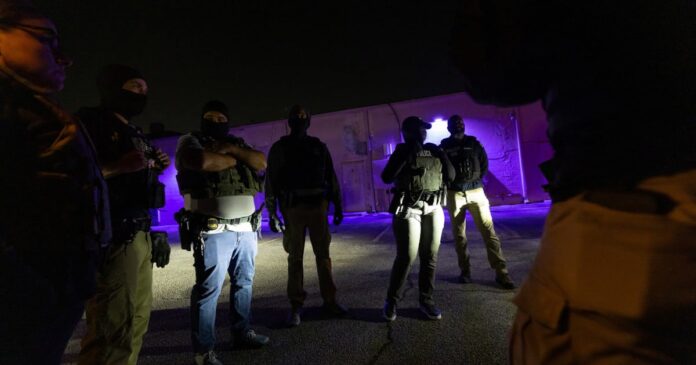"Unmasking the Truth: The Dark Reality of ICE Raids Under Trump’s Administration"
The Rise of Aggressive Immigration Tactics: A Closer Look at ICE Operations Under the Trump Administration
Date: October 10, 2023
By: [Your Name]
In recent years, the operations of Immigration and Customs Enforcement (ICE) have come under intense scrutiny, particularly during the Trump administration. Reports have surfaced detailing aggressive tactics employed by ICE officers, raising concerns about civil liberties and the treatment of immigrants in the United States. This article delves into the alarming trends observed in ICE operations, highlighting the implications for immigrant communities and the broader societal context.
Aggressive Tactics and Community Response
In June 2023, Santa Ana, California, became a focal point for ICE’s controversial tactics. Residents reported a series of raids that left many feeling terrorized. Recordings of emergency calls revealed a community in panic, with witnesses describing masked men forcibly detaining individuals in unmarked vehicles. One caller noted, “He’s bleeding,” referring to a person being pulled from a car wash and beaten before being taken away. The fear was palpable, with residents questioning the legitimacy of the agents involved, some even likening the incidents to kidnappings.
Mayor Valerie Amezcua expressed her frustration during a public meeting, questioning the lack of accountability for federal agents. “There are virtually no limits on what federal agents can do,” she stated, reflecting a sentiment echoed by many in the community. The dismantling of oversight offices within the Department of Homeland Security (DHS) has left local authorities feeling powerless to intervene.
The Erosion of Oversight
The transformation of ICE into what some officials describe as an "unfettered national police force" has been facilitated by the removal of critical oversight mechanisms. Under the Trump administration, the Office for Civil Rights and Civil Liberties (CRCL) was significantly weakened, limiting its ability to investigate complaints related to ICE’s conduct. In fiscal year 2023 alone, the CRCL processed approximately 3,000 complaints, ranging from inadequate medical treatment to allegations of sexual assault in detention centers. However, many of these complaints remain unresolved due to the office’s diminished capacity.
The current administration has allocated substantial resources to ICE, with an annual budget of $10 billion, supplemented by an additional $7.5 billion for recruitment and retention over the next four years. Critics argue that this influx of funding, coupled with lowered hiring standards, poses a significant risk to civil liberties. “Supercharging this law enforcement agency while eliminating oversight is very scary,” remarked a former DHS official.
Anonymity and Accountability
One of the most concerning aspects of ICE’s operations is the anonymity of its agents. Officers often operate without visible identification, raising questions about accountability. U.S. District Judge William G. Young recently criticized the use of masked law enforcement officers, likening it to practices associated with oppressive regimes. “In all our history, we have never tolerated an armed masked secret police,” he stated in a ruling against the administration’s tactics.
This lack of transparency has led to widespread fear among immigrant communities. In Hays County, Texas, for instance, a raid during a birthday celebration resulted in the apprehension of 47 individuals, including children. County Judge Ruben Becerra described the situation as a “kidnapping,” noting that families were left in the dark about the whereabouts of their loved ones.
The Broader Implications
The implications of ICE’s aggressive tactics extend beyond individual cases. Scholars studying authoritarianism have drawn parallels between ICE’s operations and practices seen in repressive regimes worldwide. The detention of individuals for exercising their rights, such as the case of Tufts University doctoral student Rümeysa Öztürk, has raised alarms about the erosion of democratic norms.
As communities grapple with the fear instilled by ICE’s actions, many are beginning to push back. Grassroots movements have emerged, with residents organizing to document and confront ICE operations. In Downey, California, a citizen’s intervention during an ICE raid led to the agents retreating without explanation, highlighting the potential for community resistance.
Conclusion
The current state of ICE operations under the Trump administration raises critical questions about civil liberties, accountability, and the treatment of immigrants in the United States. As communities continue to navigate the complexities of immigration enforcement, the need for oversight and transparency has never been more pressing. The ongoing dialogue surrounding these issues will be crucial in shaping the future of immigration policy and the protection of human rights in America.
For more in-depth reporting on this topic and others, consider subscribing to ProPublica’s newsletter for timely updates on investigative journalism that seeks to hold power accountable.
